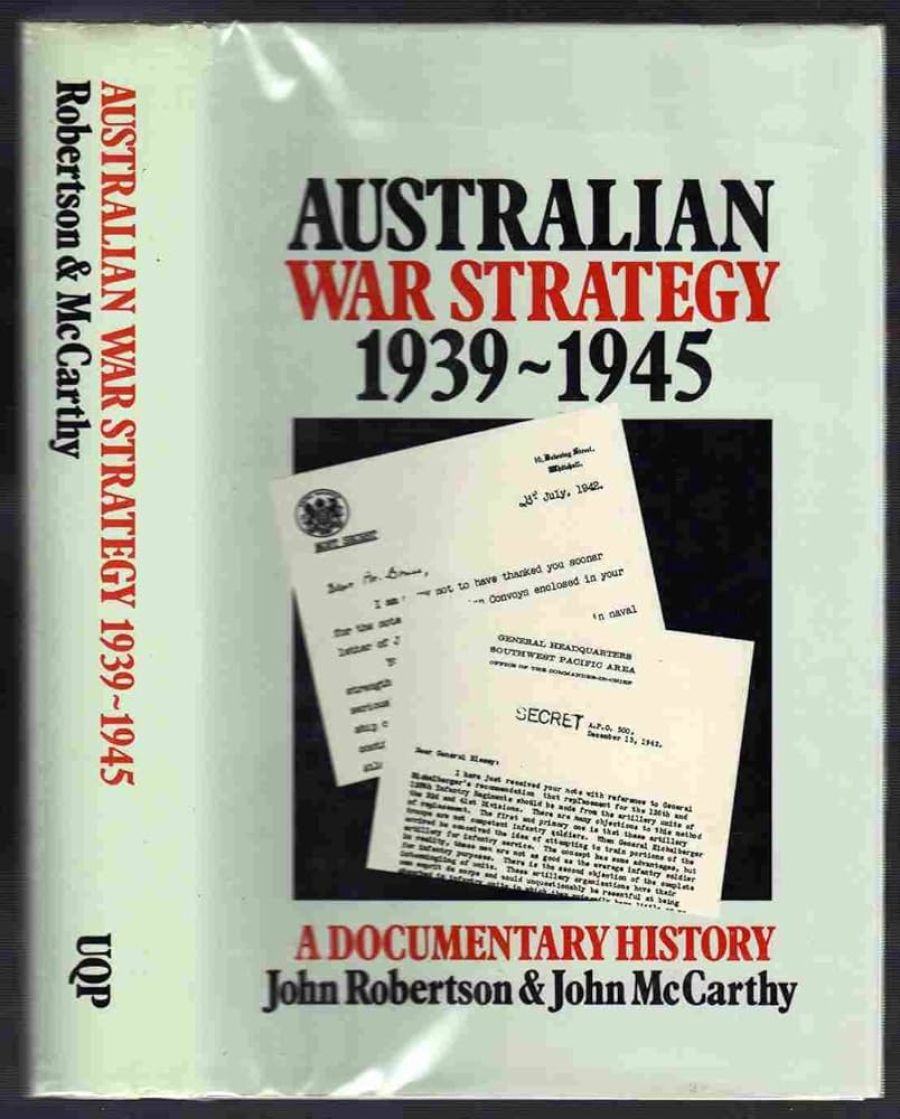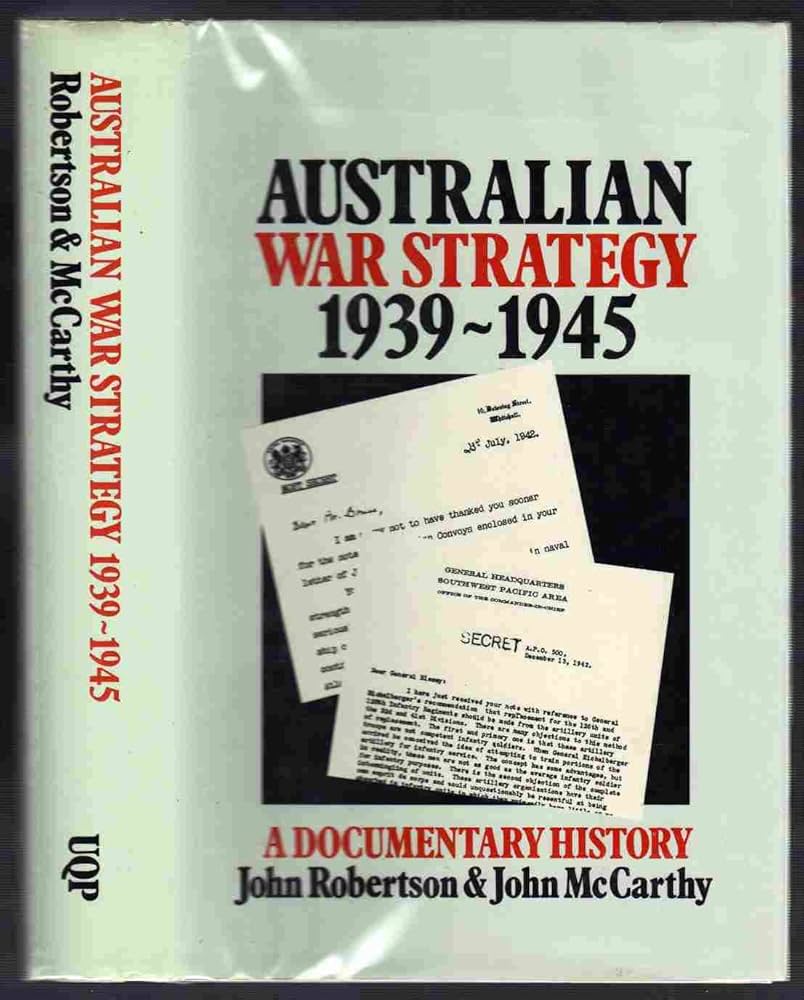
- Free Article: No
- Contents Category: War
- Review Article: Yes
- Online Only: No
- Custom Highlight Text:
Publishing collections of documents takes several forms and meets different needs. There are the great series of volumes that strive to leave nothing significant out, such as Mansergh’s Transfer of Power on Indian independence; there are the individual illustrative examples commonly published in the midst of a work of secondary prose; and there are the single volume or so works that strive to be more selective, so as to render the taste of the greater feast in more manageable proportions. These different approaches satisfy the intellectual appetite rather as a banquet, an after dinner mint and a cottage-pie respectively answer humankind’s more common hunger.
- Book 1 Title: Australian War Strategy 1939-1945
- Book 1 Biblio: University of Queensland Press, $50, 464p, 0 7022 1924X
- Book 1 Cover (800 x 1200):

Robertson and McCarthy have, as it were, baked a pie. It combines flavour with portability. They have set themselves in their preface the considerable task of seeking to compile an unofficial documentary companion to the Official History of Australia in the War of 1939-1945. Such an undertaking is in the banquet class and it would be unfair to judge the single volume work they have produced by the ambitious standard they have set themselves. They have published something less than four hundred documents or extracts to cover twenty-seven issues they see as arising from Australia’s involvement in the war. Each document has been linked to its chronological companions by explanatory paragraphs. For the period before 1944, at least, a good third of these selections have been previously published elsewhere. The editors’ decision to duplicate such publication is an odd one when it becomes apparent they were pressed for space.
The brevity imposed upon the editors by the magnitude of their subject and the limited size of their volume has produced a certain fitfulness in each of the episodes they relate. In turn, this condensation of their subjects into a limited number of documents inhibits the innate drama of many of the desperate encounters the documents of the period describe. This is particularly striking in the treatment afforded the Malaya and Burma Convoy crises, although the more limited agony of the AIF in Java is conveyed grippingly. Similarly, the great military and human trauma of General Rowell and the retreat to Imita Ridge down the Kokoda Trail is not as forcefully articulated in a limited documentary presentation as a fuller coverage might have permitted.
There are cameo appearances in this volume of great interest. The documentary account given of the British attempts to dispense with General Blarney’s services in the Middle East is sheer entertainment. The selection of pen-portraits of General MacArthur gives a quite touching summary of that gigantic personality and the reader is left in little doubt of the Supreme Commander’s supreme capacity to manage Australians. Robert Menzies’ efforts to manage Britons are likewise engagingly recreated in a letter from Sir Geoffrey Whiskard, British High Commissioner in Australia, to Anthony Eden early in 1940. The letter discusses the experience of appointments of senior British officers to high commands in Australia and reports Menzies’ belief that while ‘ ... the Admiralty and War Office now appreciated that they must not use Australia as a waste-paper basket for their duds … he was by no means sure that the Air Ministry had yet learnt this lesson’.
Menzies’ concern was prompted by the resignation of Goble, an Australian, as Chief of the Air Staff, but was to mark the beginning of the rake’s progress of the wartime high command of the RAAF. A strong feature of this book is the attention given to the unfolding Bostock-Jones controversy which bedevilled the functioning of the RAAF from 1942 onwards. Seldom has a personal feud between Australian officers been allowed such a lien on national policy. The role of Generals MacArthur and Kenny in frustrating a resolution of the dispute is illuminating particularly in the light of the limited Australian contribution to joint Allied staffwork and the opportunity to correct this situation a united RAAF leadership might have provided.
If the editors have sinned it is in that they have killed a cow for an ounce of meat. A worry with this book is the unhinted-at depths that lie beneath it. Its editors in their preface see a usefulness in providing a volume that obviates ‘the expense of a research visit and the often tedious work of searching through the archives’. This is perhaps agreeable as far as it goes. Yet the reader is given little clue of the magnitude of the documentation available on the subjects covered and of which this volume represents a tiny sample. A file citation is appended to the bottom of each document and the sum of them shows that a great lake of research has been traversed for this volume. These file citations are nowhere explained or compared, however, and in their unelucidated state would be meaningless to anyone unfamiliar with the workings of Australian Archives or the Public Record Office. Similarly, a preference is exhibited for recording high political direction in the form of War Cabinet Minutes. This is understandable on the grounds of conciseness, but the reader would be far further ahead if he were made aware that brief Cabinet decisions appearing by themselves as sequential minutes are derived from far longer and more argued Cabinets submissions and a range of supporting documents and cables. To acknowledge the whereabouts of such source material with even a footnote would alert the reader to its importance and would place the published Minutes in a better context.
Fortunately such devices do not inhibit the thrust of many of the matters related. The account of the Australian involvement in Syria in 1941 is a model of how a story can be plainly put with a careful selection of limited documents. Among other things the editors confirm that Australian troops, who formed the bulk of the Allied attacking force, invaded Vichy-French-held Syria without the Australian Government being aware in advance.
The editors have produced a work that is illustrative of the six years of war as much as chronological of it. The book is clearly laid out and very well indexed, and includes a set of biographical notes. Senior secondary history courses may very well find value in this study as a basic text introducing students to the use of documents in the study of history.


Comments powered by CComment